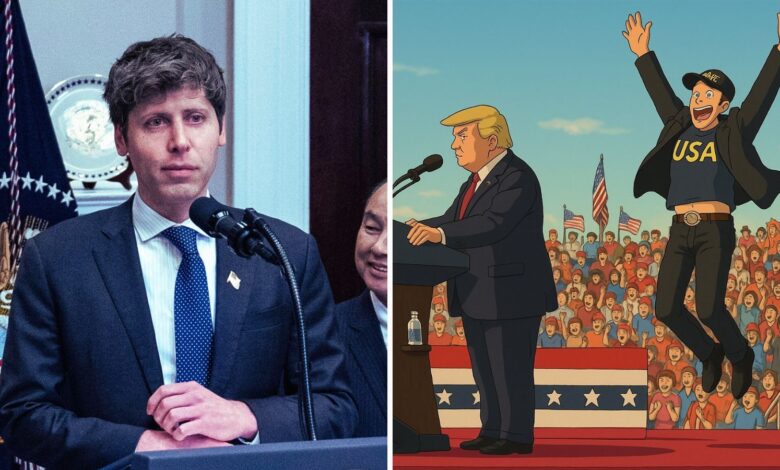Sam Altman says OpenAI’s GPUs are ‘melting’ over Ghibli-style AI art: What it means | Technology News

As the controversies surrounding AI emulating the style of Studio Ghibli, OpenAI seems to have run into a fresh conundrum. OpenAI CEO Sam Altman, while hailing the response to the latest image generator, has said that the company’s GPUs are melting. Altman added that the company is limiting the feature’s usage. In essence, the company is being forced to limit how many images ChatGPT generates. Altman said that the free tier will be able to produce three images per day.“It’s super fun seeing people love images in ChatGPT. But our GPUs are melting. We are going to temporarily introduce some rate limits while we work on making it more efficient. Hopefully it won’t be long! ChatGPT’s free tier will get 3 generations per day soon,” wrote Altman in his X post. Following the resounding success of the image generator’s capability, Altman had changed his display picture with a Ghibli-fied image of himself.
it’s super fun seeing people love images in chatgpt.
but our GPUs are melting.
we are going to temporarily introduce some rate limits while we work on making it more efficient. hopefully won’t be long!
chatgpt free tier will get 3 generations per day soon.
— Sam Altman (@sama) March 27, 2025
OpenAI unveiled the native image generator on Tuesday to an overwhelming response. The Sam Altman-led company introduced the tool as a high-quality image generator within ChatGPT. The new tool is offered as a means to generate images, diagrams, logos, infographics, stock photos, business cards, etc. One of the noteworthy features of the tool has been its ability to use an external image as a starting point for art, which can be modified into a painting or a professional headshot.
What is a GPU, and how can it melt?
Altman saying that the new image generator is melting GPUs is not plain humour. Generative AI tools such as ChatGPT, DALL-E, and even autonomous cars rely heavily on massive amounts of computing power. And, at the heart of this computing power is the GPU, or the graphics processing unit. In order to understand why GPUs are melting, one needs to know how they work and why modern AI systems rely on them so heavily.
Story continues below this ad
In elementary school, we have been taught how the CPU, or central processing unit, works as the brain of the computer. The CPU is known to handle all kinds of tasks, be it running the web browser, playing music, loading applications, etc. Just like the human brain (absolutely no comparison here), the CPU can multitask. However, with AI systems, there is a need for something more. Unlike your traditional computer that does a lot of small tasks in quick succession, AI systems need to work iteratively, meaning they need to do the same math problems multiple times, maybe even a million times over. This requires massive amounts of data, and that too, all at once. This is where the GPU comes into the picture.
To simplify further, one can think of a CPU as someone who can bake a cake with perfection, albeit one at a time. Whereas a GPU is like having an entire bakery that can quite literally bake thousands of cakes at once. If you trace back the hory of GPUs, they were a concept in the late 1980s. They evolved with time, essentially calling for a separate story. However, one needs to note that GPUs were initially developed to render video game graphics, and this is why they were called GPUs. However, today they have transformed into the go-to engines for training and running artificial intelligence models.
How powerful is a GPU, actually?
If you think of it, the Super Mario 64 game released in 1996 needed about 100 million calculations every second. And this would translate into around 36 trillion calculations per second for a modern game like Cyberpunk 2077. This kind of computational power is needed to create real-time visual effects such as lighting, shadows, and all those lifelike details one could see in a video game.
When it comes to ChatGPT or DALL-E, they demand substantially more power than video games. This is because these AI systems are doing billions or even trillions of math operations, matrix multiplications to be precise, across massive amounts of data. What Sam Altman meant when he said OpenAI’s GPUs were melting is that they were being pushed to the limit, as owing to the excessive user demand, they were seemingly running nonstop at full capacity. Story continues below this ad
How is a GPU ideal for AI systems?
Modern GPUs come with thousands of tiny processors, also known as cores. For example, the NVIDIA RTX 3090 comes with over 10,000 cores, and most of them are known as CUDA cores – the processing units with NVIDIA GPUs designed for parallel computing. These cores are like tiny calculators, and some of these are capable of handling AI tasks and are known as Tensor Cores. All of these cores work simultaneously, essentially meaning that they can manage different parts of a big problem at the same time. This type of mechanism is ideal for AI.
To simplify, think of applying a filter on a life-sized painting pixel pixel; a GPU can do this super fast, as it would assign different cores to different pixels. This is the same mechanism applied for a neural network that analyses millions of words and generates images pixel pixel; it’s just that it would be a lot more intense. GPUs are not only calculating faster, but they are also moving data in and out almost instantly. This is why GPUs come with high-speed memory that is capable of transferring terates of data every second.
Why are AI companies obsessed with GPUs?
As we know, training a large AI model may take weeks, months or even years of nonstop processing of GPUs. Once they are trained, these models are capable of generating any kind of text, image, audio, or code. This is why Google, OpenAI, Meta, etc., have been building enormous data centres loaded with GPUs. This often costs millions of dollars; hence, they are called the new oil rigs of the digital age. At present, the demands for GPUs are so high that they are constantly on backorder. With AI models getting larger and more advanced, more power is needed.
Back to the new image generator, what began as a trend among social media users soon snowballed into a controversy over copyright, arts and the right to their work. Many ardent fans of Ghibli films expressed their displeasure over the use of the image generator to colour horical events, often grotesque tragedies, with the brushstroke of celebrated Ghibli filmmaker Hayao Miyazaki.Story continues below this ad
Films Ghibli have underscored the simple pleasures of life, often weaving quiet and contemplative everyday stories with universal themes. They have showcased the abject miseries caused wars, natural disasters, and the quintessential human condition. Miyazaki’s idyllic visuals with deeply humane characters at the heart of the storytelling have won enduring patronage and are likely to be celebrated in the canon of great filmmaking for years.



